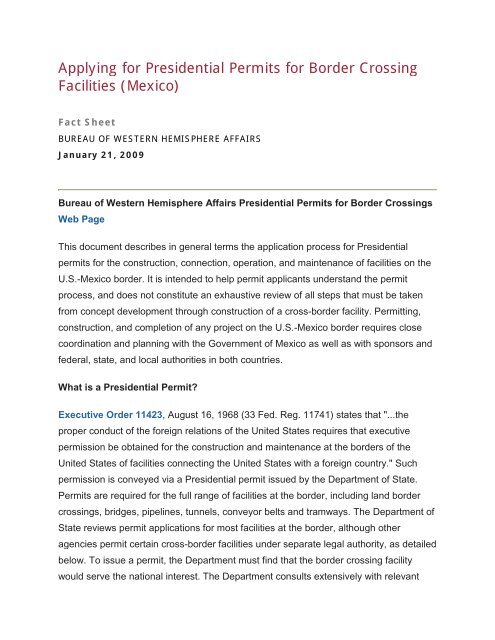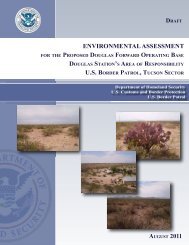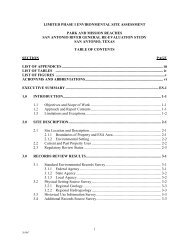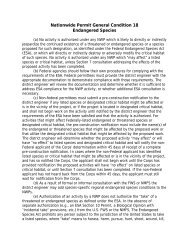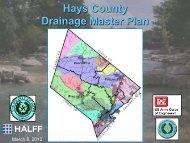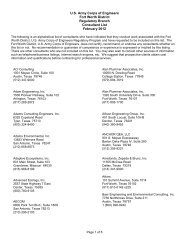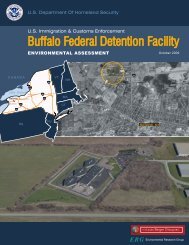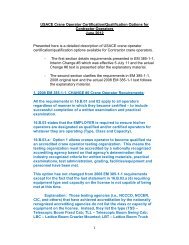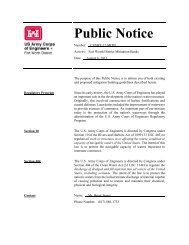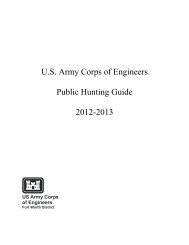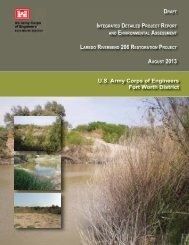Applying for Presidential Permits for Border Crossing Facilities ...
Applying for Presidential Permits for Border Crossing Facilities ...
Applying for Presidential Permits for Border Crossing Facilities ...
- No tags were found...
Create successful ePaper yourself
Turn your PDF publications into a flip-book with our unique Google optimized e-Paper software.
federal, state, and local agencies, and invites public comment in arriving at itsdetermination.Legal AuthoritiesThe Department's legal authority to issue <strong>Presidential</strong> permits <strong>for</strong> land border crossings,international bridges, pipelines and certain other transboundary facilities is found inExecutive Order 11423 of August 16, 1968, as amended by Executive Order 12847 ofMay 17, 1993 (58 Fed. Reg. 29511), Executive Order 13284 of January 23, 2003 (68Fed. Reg. 4075), and Executive Order 13337 of April 30, 2004 (69 Fed. Reg. 25299)and, to the extent applicable, the International Bridge Act of 1972 (33 U.S.C. Section535 et seq.). In considering whether to issue a permit, the Department complies with theNational Environmental Policy Act (NEPA) of 1969 (42 U.S.C. Section 4321 et seq.) andits implementing regulations, the National Historic Preservation Act (NHPA) of 1966 (16U.S.C. Section 470f), and Executive Order 12898 of February 11, 1994 (59 Fed. Reg.7629), concerning environmental justice.Early Consultations Are DesirableApplicants should consult as early as possible with relevant federal and state agencies.Such consultations help the applicant understand the application process and addresspossible concerns at an early date. At the federal level, applicants should consult withthe General Services Administration, the Department of Transportation's FederalHighway Administration, the Department of Homeland Security's Bureau of Customsand <strong>Border</strong> Protection, the Environmental Protection Agency, the Department of theInterior's Fish and Wildlife Service, the Coast Guard (if the project is an internationalbridge), and the U.S. Section of the International Boundary and Water Commission, aswell as the Department of State. At the state and local level, the applicant shouldconsult with appropriate agencies, including those responsible <strong>for</strong> highways, theenvironment, parks, wildlife, and historic and cultural preservation.
Project Categories and NotificationA <strong>Presidential</strong> permit is required <strong>for</strong> all new border crossings as well as <strong>for</strong> allsubstantial modifications of existing border crossings. As described in InterpretativeGuidance that it published in the Federal Register on February 23, 2007, theDepartment has identified three categories of non-pipeline projects <strong>for</strong> purposes ofnotification of the Department of State. These three categories set out below, which arebased on the magnitude and complexity of the proposed change(s) at the border, areintended to provide guidance on the exercise of the Department's permittingresponsibilities.• Red (both notification of the Department and new or amended <strong>Presidential</strong> permit arerequired): (1) all new border crossings and (2) proposed changes that wouldsubstantially modify an existing border crossing.• Yellow (notification of the Department required and a <strong>Presidential</strong> permit may berequired): modification of an existing border crossing that may have a material effect onCanadian or Mexican government operations in their respective country. The sponsormust notify the Department of its plans. The Department will decide if a <strong>Presidential</strong>permit is required within a specified period.• Green (neither Department notification nor <strong>Presidential</strong> permit required): changes in theproximity of the border that are not expected to have a material effect on Canadian orMexican government operations in their respective country and are neither new bordercrossings nor substantial modifications to existing border crossings.How to Apply and What to Include in the ApplicationApplications <strong>for</strong> <strong>Presidential</strong> permits <strong>for</strong> land border crossings, international bridges, andcertain other transboundary facilities at the U.S.-Mexico border are made to:Secretary of StateAttention: Coordinator <strong>for</strong> U.S.-Mexico <strong>Border</strong> AffairsWHA/MEX Room 3909Department of State
2201 C Street NWWashington, DC 20520Applicants should deliver five printed copies of the completed application to theDepartment and also send the application (divided into PDF files of no more than 5 Mbeach) by e-mail to WHA-<strong>Border</strong>Affairs@state.gov, so that it can be efficientlydistributed to other agencies <strong>for</strong> their review.See below <strong>for</strong> in<strong>for</strong>mation about submitting applications <strong>for</strong> facilities at the U.S.-Canadaborder or <strong>for</strong> oil or liquids pipelines.<strong>Presidential</strong> permit applications should include the following:• Identifying In<strong>for</strong>mation. In<strong>for</strong>mation precisely identifying the person, entity, or entitiesapplying <strong>for</strong> the permit. If the applicant is a county, municipality, or other public body,the applicant should state its legal authority to make the application. If the applicant isan entity (partnership, corporation, etc.), the application should identify the individual,entity, or entities that holds a controlling interest in the applicant and that will be makingfinal decisions on behalf of the applicant concerning the construction, connection,operation, and maintenance of the proposed border facility. The application shouldspecify any intention on the part of the applicant to transfer, sell, or assign to any otherentity the facility <strong>for</strong> which approval is sought.• Description of Facility. A detailed description of the proposed facility, including itslocation, design, the safety standards to be applied, access routes, and details of theproposed construction methods. The application should also include photographs of theconstruction site; maps that identify the parcel of land that the sponsor intends toprovide as a site <strong>for</strong> the border crossing, if applicable; engineering drawings includingthe anticipated cross-section, technical specifications, and such other explanatorymaterials as are available.• National Interest. An explanation of how the proposed facility would serve the nationalinterest. This explanation may be supported by any reports, correspondence, and othermaterial indicating the desirability and feasibility of the proposed facility.
• Similar <strong>Facilities</strong>. A map that identifies similar facilities in the area, and a list of thenames and addresses of their owners.• Traffic In<strong>for</strong>mation. In<strong>for</strong>mation about current and projected levels of international roadtraffic and a description of the road system that would serve the facility on each side ofthe border. The application should discuss the project's consistency with state andregional plans as well as commitments to ensure an adequate support infrastructure,including access roads. The application should project the type and volume of trafficthat the proposed border crossing will accommodate, as well as the effect that trafficwould have on, and its compatibility with, the existing road system and nearby bridgesand border crossings. Maps showing U.S. and Mexican roads with traffic counts, weightor other use restricted routes, and any roads that would be built along with the facilitywould be helpful. These maps and other application materials should show from wherethe projected traffic is expected to come and the likely impact of any traffic diversioncaused by the facility on other border crossings. This in<strong>for</strong>mation will help establishrequirements <strong>for</strong> any inspection facility at the proposed border facility.• Construction Plan. A plan <strong>for</strong> construction of the facility, including an expectedschedule <strong>for</strong> securing other necessary permits and approvals, financing, andconstruction. The applicant should identify any specific problems anticipated in thedevelopment and construction of the facility along with an indication of how they mightbe resolved.• Financing. The estimated cost of the project, including inspection facilities andinspection agency staffing, and an explanation of how the applicant will finance thatcost, including, if applicable, the proposed toll structure. If the facility, including anyaccess roads, will involve approval or funding from state or federal sources, theapplication should so specify and should indicate the steps that have been or will betaken to secure such approval and/or funding.• Mexican Approvals. In<strong>for</strong>mation showing how the project fits with Mexicandevelopment plans and priorities and a description of all steps that the applicant hastaken or will take to secure the approval of local, state, and federal officials in Mexico.The Government of Mexico has asked that applications be made at the same time in thetwo countries. The applicant should indicate any known views of Mexican officialsregarding the facility and describe general arrangements <strong>for</strong> financing, construction, and
ownership of the Mexican portion of the facility. The applicant should attach copies ofany agreements or understandings about these matters. Under the 1972 InternationalBridge Act, the applicant must obtain all required authorizations from Mexican officialsbe<strong>for</strong>e the Department of State may approve an international bridge. It is not necessaryto satisfy all Mexican requirements be<strong>for</strong>e applying <strong>for</strong> a <strong>Presidential</strong> permit. However,to avoid the unnecessary expenditure of resources by both the U.S. Government andthe applicant, the applicant should present evidence that Mexican authorities do notobject to the construction of the proposed facility.• Other U.S. Approvals. A list of all permits or approvals from U.S. federal, state, andlocal agencies that the applicant believes are required in connection with the proposedfacility, and a description of what steps have been or will be taken to secure them.• Historic Preservation. A list of all properties in the project area which are included in orpotentially eligible <strong>for</strong> inclusion in the National Register of Historic Properties. Pursuantto the National Historic Preservation Act (section 106), the Department must considerthe effects of the proposed facility on such properties and seek concurrence from theappropriate State Historic Preservation Office. The Department may also seek commentfrom the Advisory Council on Historic Preservation, an independent federal agencyestablished under the NHPA.• Environmental Justice. In<strong>for</strong>mation on minority and low-income populations likely tobe affected by construction of the proposed facility. This in<strong>for</strong>mation assists theDepartment in fulfilling its obligations pursuant to Executive Order 12898 onenvironmental justice.Environmental ReviewIn addition to the above, the applicant should include in<strong>for</strong>mation about <strong>for</strong>eseeableenvironmental impacts of the proposed facility. Pursuant to NEPA, in considering anapplication <strong>for</strong> a <strong>Presidential</strong> permit, the Department must take into accountenvironmental impacts of the proposed facility and directly related construction.Environmental impacts may be direct, indirect, or cumulative. Prior to deciding whetherto issue the <strong>Presidential</strong> permit, the Department may be required to prepare, circulate<strong>for</strong> comment, and file environmental documentation. Applications should include anyenvironmental documentation applicants believe is required under NEPA and the
egulations found in 40 CFR Parts 1500-1508, whether that is an environmentalassessment (EA) or an environmental impact statement (EIS). If an EA is produced andthere is a finding of potential significant impacts, under NEPA an EIS must beconducted.For additional in<strong>for</strong>mation about NEPA, please see the federal government's NEPA website at http://www.nepa.gov. The Department's NEPA implementing regulations arelocated at http://www.state.gov/documents/organization/22979.doc. To furtherunderstand the issues that will need to be addressed in your environmentalassessment, you may want to consult the following guidance documents from otherfederal agencies:• http://www.eh.doe.gov/nepa/tools/guidance/volume2/2-3-eachecklist.pdf• http://www.ferc.gov/industries/gas/enviro/applcgrf.pdf• http://www.fws.gov/r9esnepa/checklists/EAEISOutline.PDFAgency Review and Public CommentOnce the application is complete, the Department will instruct the applicant to providecopies -- including all environmental and other documentation -- to relevant federal andstate agencies <strong>for</strong> their comment. The Department will also publish a notice in theFederal Register inviting public comment on the application. If the proposed facility islocated within or near an area declared to be a Clean Air Act non-attainment area underthe, the Department must engage in additional consultation with the EnvironmentalProtection Agency and appropriate state agencies concerning the level of environmentaldocumentation required. Should questions from the agencies arise during the review,they will be referred to the applicant. The Department, participating agencies, and theapplicant will work together to resolve such questions.The applicant may be required to prepare additional documents reflecting anyagreements made in the course of mitigation and/or addressing agency concerns. TheDepartment would then circulate the supplemental in<strong>for</strong>mation <strong>for</strong> final agency review. Ifthe Department determines that the project would have no significant environmental
impact, the Department will issue a Finding of No Significant Impact (FONSI) andpublish it in the Federal Register. If it finds a significant impact, or in other appropriatecircumstances, the applicant must arrange <strong>for</strong> the hiring of a third party environmentalcontractor to prepare a full environmental impact statement (EIS) be<strong>for</strong>e the permitapplication may be considered further.National Interest Determination and Permit IssuanceExecutive Order 11423 specifies certain federal officials with whom the Departmentmust consult when reviewing a permit application. The Department may also consultwith other federal, state, and local government officials, and it will consider all viewsexpressed, including public comment, be<strong>for</strong>e making a decision on a permit. Whenthese consultations are complete, the Secretary of State or the Secretary's designee willdecide whether issuance of a permit to the applicant would be in the national interest. Ifa positive determination is made, the Department in<strong>for</strong>ms federal agencies of itsintention to issue a <strong>Presidential</strong> permit. Barring objection(s) from any of the officialsspecified in the Executive Orders, the Department will issue the <strong>Presidential</strong> permit 15days thereafter. In the case of an objection, the Secretary of State will refer the matterdirectly to the President <strong>for</strong> a final decision.Other Necessary Approvals Prior to Authorizing Construction1. Under the provisions of the International Bridge Act of 1972 (22 U.S.C. 535, 535c-535h), the Coast Guard has jurisdiction over the construction, modification, operation,and maintenance of any bridge connecting the United States with a <strong>for</strong>eign country.Applicants should consult with the Coast Guard directly regarding its permittingprocess.2. Plans <strong>for</strong> construction of the proposed facility must be submitted to the InternationalBoundary and Water Commission (IBWC), the U.S. section of which is located in ElPaso, Texas, and the Mexican section in Ciudad Juarez, Mexico, <strong>for</strong> its approval. TheIBWC will assess whether the effects of the facility will be consistent with existingbilateral arrangements between the United States and Mexico; will obscure or otherwise
affect the boundary between the United States and Mexico; and, if applicable, willchange the course of the Rio Grande or increase the risk of flooding.Bilateral Coordination with the Government of MexicoThe Department coordinates closely with the Government of Mexico through theSecretariat of Foreign Relations (SRE) and the Embassy of Mexico on issues affectingthe U.S.-Mexico border. The Department communicates with the Government of Mexicovia diplomatic notes at various stages in the permit process. For example, theDepartment in<strong>for</strong>ms the Government of Mexico via diplomatic note when it receivespermit applications and when it issues permits. Construction generally cannot beginuntil the U.S. and Mexican Governments exchange diplomatic notes specificallyauthorizing construction. The Department must approve any contractual arrangementbetween state or local authorities and Mexican federal, state, or municipal authoritiesconcerning construction of the facility prior to the exchange of notes authorizingconstruction. Permittees must keep the Department in<strong>for</strong>med of all significantdevelopments related to construction so that the Department may conduct thenecessary bilateral coordination with the Government of Mexico concerning the bordercrossing facility.Natural Gas Pipelines and Electrical ConnectionsAlthough the Department of State processes permits <strong>for</strong> most cross-border facilities,there are some exceptions. <strong>Presidential</strong> permits <strong>for</strong> electrical lines are processed by theDepartment of Energy, while <strong>Presidential</strong> permits <strong>for</strong> natural gas pipelines areprocessed by the Federal Energy Regulatory Commission. Both permits are issuedunder Executive Order 10485 of 1953, as amended by Executive Order 12038.Questions about <strong>Presidential</strong> permits <strong>for</strong> electrical lines should be directed to theDepartment of Energy at (202) 586-9624; <strong>for</strong> natural gas pipelines, to the FederalEnergy Regulatory Commission at (202) 208-2245.More In<strong>for</strong>mation
For more in<strong>for</strong>mation about <strong>Presidential</strong> permits <strong>for</strong> facilities at the U.S.-Mexico border,please contact the Department's Office of Mexican Affairs at the address below, byphone at (202) 647-9894, or by e-mail at WHA-<strong>Border</strong>Affairs@state.gov.Coordinator <strong>for</strong> U.S.-Mexico <strong>Border</strong> AffairsWHA/MEX, Room 3909Department of State2201 C Street NWWashington, DC 20520For more in<strong>for</strong>mation about <strong>Presidential</strong> permits <strong>for</strong> oil and liquids pipelines, pleasecontact the Department's Office of International Energy and Commodities Policy at theaddress below or at (202) 647-1291.Office of International Energy and Commodities PolicyMail Stop EEB/ESC/IECDepartment of State2201 C Street NWWashington, DC 20520For more in<strong>for</strong>mation about <strong>Presidential</strong> permits <strong>for</strong> facilities at the U.S.-Canada border,please contact the Department's Office of Canadian Affairs at the address below or at(202) 647-2170.Economic OfficerWHA/CAN, Room 3917Department of State2201 C Street NWWashington, DC 20520


